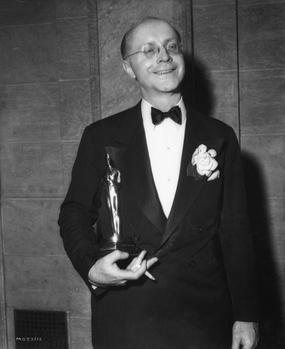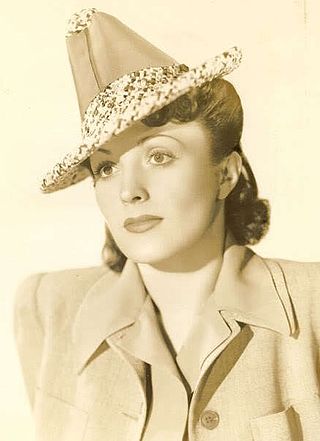Kitty Foyle may refer to:

Christopher Darlington Morley was an American journalist, novelist, essayist and poet. He also produced stage productions for a few years and gave college lectures.

Glenn Miller and His Orchestra was an American swing dance band formed by Glenn Miller in 1938. Arranged around a clarinet and tenor saxophone playing melody, and three other saxophones playing harmony, the band became the most popular and commercially successful dance orchestra of the swing era and one of the greatest singles charting acts of the 20th century. As of 2023, Ray Anthony is the last surviving member of the orchestra.

The Time of Your Life is a 1939 five-act play by American playwright William Saroyan. The play is the first drama to win both the Pulitzer Prize for Drama and the New York Drama Critics Circle Award. The play opened on Broadway in 1939.
Robert De Grasse was an American cinematographer and member of the American Society of Cinematographers. Over the course of his career, he was nominated for an Academy Award in 1939 and a Primetime Emmy Award in 1958.

Donald Ogden Stewart was an American writer and screenwriter best known for his sophisticated golden age comedies and melodramas such as The Philadelphia Story, Tarnished Lady and Love Affair. Stewart worked with a number of the directors of his time, including George Cukor, Michael Curtiz and Ernst Lubitsch. Stewart was a member of the Algonquin Round Table and, with Ernest Hemingway's friend Bill Smith, the model for Bill Gorton in The Sun Also Rises. His 1922 parody on etiquette, Perfect Behavior, published by George H. Doran and Co., was a favourite book of P. G. Wodehouse.
This is a list of bestselling novels in the United States in the 1930s, as determined by Publishers Weekly. The list features the most popular novels of each year from 1930 through 1939.

Faith Baldwin was an American writer of romance novels and other forms of fiction, often concentrating on women characters juggling career and family. The New York Times wrote that her books had "never a pretense at literary significance" and were popular because they "enabled lonely working people, young and old, to identify with her glamorous and wealthy characters".
The Baby Train, or simply Baby Train, is an urban legend told in the United States, United Kingdom and Australia. The legend first appeared in Christopher Morley's 1939 novel Kitty Foyle. According to the legend, a certain small town had an unusually high birth rate. This was allegedly caused by a freight train passing through the town and blowing its whistle, waking up all the residents. Since it was too late to go back to sleep and too early to get up, couples would have sex. This resulted in a mini-baby boom.

Barbara Bedford was an American actress who appeared in dozens of silent movies. Her career declined after the introduction of sound, but she continued to appear in small roles until 1945.

Kitty Foyle, subtitled The Natural History of a Woman, is a 1940 drama film starring Ginger Rogers, Dennis Morgan and James Craig, based on Christopher Morley's 1939 bestseller Kitty Foyle. Rogers won the Academy Award for Best Actress for her portrayal of the title character, and the dress she wore in the film became known as a Kitty Foyle dress.

Theodore von Eltz was an American film actor, appearing in more than 200 films between 1915 and 1957. He was the father of actress Lori March.
In the British Army, a gentleman ranker is an enlisted soldier suited through education and social background to be a commissioned officer or indeed a former commissioned officer. Rudyard Kipling titled one of his poems, which was published in 1892, "Gentlemen-Rankers".

Florence Bates, was an American film and stage character actress who often played grande dame characters in supporting roles.

Edna Cecil Cunningham was an American film and stage actress, singer, and comedienne.

Mary Katherine Linaker was an American actress and screenwriter who appeared in many B movies during the 1930s and 1940s, most notably Kitty Foyle (1940) starring Ginger Rogers. Linaker used her married name, Kate Phillips, as a screenwriter, notably for the cult movie hit The Blob (1958). She is credited with coining the name "The Blob" for the movie, which was originally titled "The Molten Meteor".

Random Harvest is a novel written by James Hilton, first published in 1941. Like previous Hilton works, including Lost Horizon and Goodbye, Mr. Chips, the novel was immensely popular, placing second on Publishers Weekly list of best-selling novels for the year, and it was published as an Armed Services Edition during WWII.

Mary Treen was an American film and television actress. A minor actress for much of her career, she managed to secure a plain, unassuming niche for herself in dozens of movies and television shows during the Hollywood of the 1940s, 1950s and 1960s in a career spanning more than 40 years.
Kitty Foyle is an American old-time radio and television soap opera originally aired during the 1940s and 1950s that was based on the 1940 film of the same name starring Ginger Rogers. Kitty Foyle was created by soap opera mogul Irna Phillips of Guiding Light fame and produced by daytime radio monarchs Frank and Anne Hummert of Helen Trent recognition. The program originally starred Julie Stevens in the title role of Kitty Foyle on radio. On television, the title role was portrayed by Kathleen Murray.

The Ginger Rogers filmography lists the film appearances of American actress Ginger Rogers, as well as her television, stage, and radio credits. Rogers's career spanned fifty-seven years, from 1930 to 1987.














